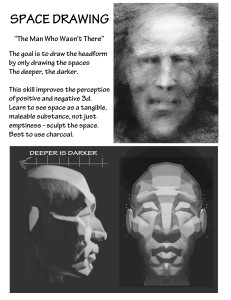 Earlier this year, RL thought of developing the “space-head” exercise from my class for use in her Masters Thesis in Education. I wondered how she made out: On Sun, 07 Jun 2015 20:00:03 -0700, RL wrote: “Hi Tony, How nice to hear from you! All aspects of my thesis were well received, but none more so than the video of the “space-head” you helped me to create. The iMovie/self-portrait I made was suggestive, just as you say, of the process of emergence – in all its ambiguity and uncertainty – that I experience in my professional life as an educator and that was very much a part of my thesis work. I’m very grateful for the opportunity I had to work with you and all that I learned about drawing and about myself as a result. … Looking forward to seeing you in July at the Shadbolt.” RL
Earlier this year, RL thought of developing the “space-head” exercise from my class for use in her Masters Thesis in Education. I wondered how she made out: On Sun, 07 Jun 2015 20:00:03 -0700, RL wrote: “Hi Tony, How nice to hear from you! All aspects of my thesis were well received, but none more so than the video of the “space-head” you helped me to create. The iMovie/self-portrait I made was suggestive, just as you say, of the process of emergence – in all its ambiguity and uncertainty – that I experience in my professional life as an educator and that was very much a part of my thesis work. I’m very grateful for the opportunity I had to work with you and all that I learned about drawing and about myself as a result. … Looking forward to seeing you in July at the Shadbolt.” RL
Here is where the title expression came from:
“Antigonish” is an 1899 poem by American educator and poet Hughes Mearns. Check it and him out in Wiki. It is also known as “The Little Man Who Wasn’t There“, It is a very ambiguous, existential, ghostly and suggestive phrase that has been used to inspire plays, lines in movies, a hit song, novels and lately a Coen Bros. movie. It also seemed to fit with an exercise that I use in my classes in drawing. Here we try to draw a head – without actually directly drawing the head, by working as if is a form under water and drawing the water instead of the form, thus revealing the face through many small ‘encounters’. I call it a ‘space drawing’, or ‘space-head’ because we try to draw the space and thus reveal the head-form. Sounds strange, but it builds the ability to see space as an actual, tangible substance, just as important as form. (Here I refer to 3D sculptural/architectural space- counterpart of form, not the 2D space of negative flat shapes.)